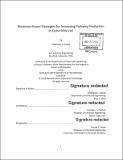| dc.contributor.advisor | Kristala L. J. Prather. | en_US |
| dc.contributor.author | Doong, Stephanie J. | en_US |
| dc.contributor.other | Massachusetts Institute of Technology. Department of Chemical Engineering. | en_US |
| dc.date.accessioned | 2019-11-22T00:09:56Z | |
| dc.date.available | 2019-11-22T00:09:56Z | |
| dc.date.copyright | 2019 | en_US |
| dc.date.issued | 2019 | en_US |
| dc.identifier.uri | https://hdl.handle.net/1721.1/123072 | |
| dc.description | Thesis: Ph. D., Massachusetts Institute of Technology, Department of Chemical Engineering, 2019 | en_US |
| dc.description | Cataloged from PDF version of thesis. | en_US |
| dc.description | Includes bibliographical references (pages 112-120). | en_US |
| dc.description.abstract | Microbial production of chemicals and fuels is an attractive renewable alternative to petroleum-based processes. D-glucaric acid, a Department of Energy top value-added chemical from biomass, is a precursor to polymers such as nylons and used in detergents. An engineered metabolic pathway requiring three heterologous enzymes to convert glucose into glucaric acid in Escherichia coli was previously demonstrated by the Prather lab. Glucaric acid production has been shown to be limited by the two downstream enzymes myo-inositol-1-phosphate synthase (MIPS) and myo-inositol oxygenase (MIOX). This work develops and deploys a biosensor that recognizes a pathway intermediate in order to overcome both limitations. A biosensor for myo-inositol (MI) was developed using the transcriptional regulator IpsA from the organism Corynebacterium glutamicum. A hybrid promoter was designed to enable function in the desired host organism E. coli. | en_US |
| dc.description.abstract | The modular design of the biosensor permitted the behavior and Ml dose response to be adjusted for the pathway applications. The myo-inositol biosensor was used to regulate expression of Miox, the enzyme that consumes myo-inositol, such that Miox was transcribed only in the presence of its substrate. Controlled expression of Miox led to a 2.5-fold increase in glucaric acid titer compared to the static case where Miox was constitutively expressed. This dynamic regulation scheme was then paired with a system that dynamically knocked down glycolysis, which independently improved glucaric acid production by relieving competition of glycolysis with MIPS, the first pathway enzyme. The layered dynamic regulation scheme improved glucaric acid production by up to 9-fold. Next, the biosensor was used as a high-throughput screen for mutants of MIPS generated by directed evolution. The biosensor enabled a large library of MIPS to be screened by fluorescence-activated cell sorting (FACS). | en_US |
| dc.description.abstract | The screen identified MIPS mutants with up to 20% improvement in myo-inositol production. This work used a biosensor to tackle two pathway limitations and improve glucaric acid production, showcasing the biosensor as a powerful metabolic engineering tool. | en_US |
| dc.description.statementofresponsibility | by Stephanie J. Doong. | en_US |
| dc.format.extent | 120 pages | en_US |
| dc.language.iso | eng | en_US |
| dc.publisher | Massachusetts Institute of Technology | en_US |
| dc.rights | MIT theses are protected by copyright. They may be viewed, downloaded, or printed from this source but further reproduction or distribution in any format is prohibited without written permission. | en_US |
| dc.rights.uri | http://dspace.mit.edu/handle/1721.1/7582 | en_US |
| dc.subject | Chemical Engineering. | en_US |
| dc.title | Biosensor-based strategies for improving pathway production in Escherichia coli | en_US |
| dc.type | Thesis | en_US |
| dc.description.degree | Ph. D. | en_US |
| dc.contributor.department | Massachusetts Institute of Technology. Department of Chemical Engineering | en_US |
| dc.identifier.oclc | 1127388287 | en_US |
| dc.description.collection | Ph.D. Massachusetts Institute of Technology, Department of Chemical Engineering | en_US |
| dspace.imported | 2019-11-22T00:09:55Z | en_US |
| mit.thesis.degree | Doctoral | en_US |
| mit.thesis.department | ChemEng | en_US |
